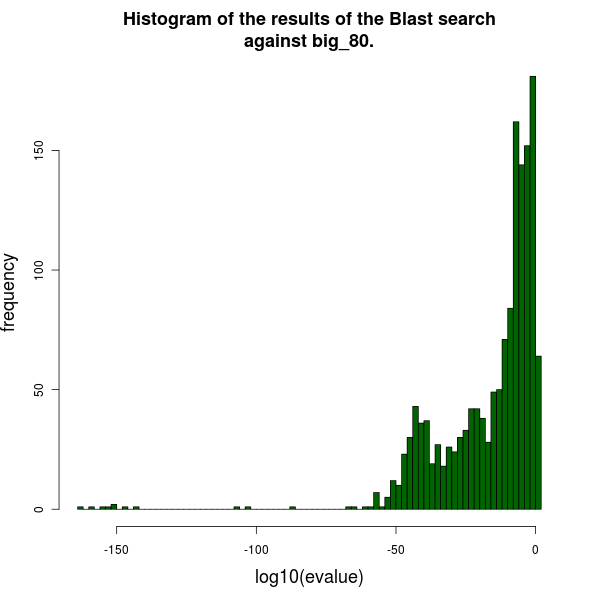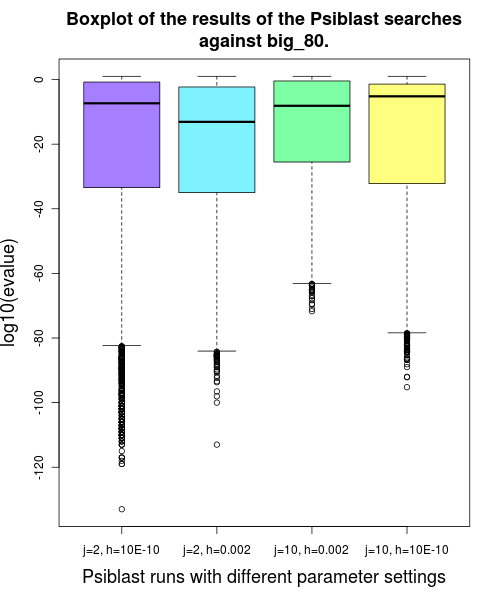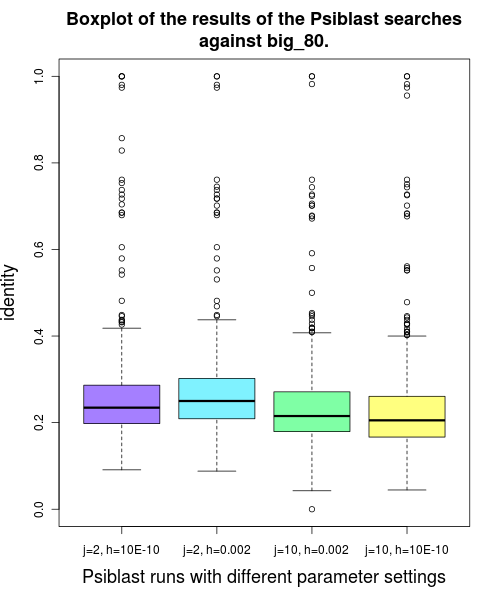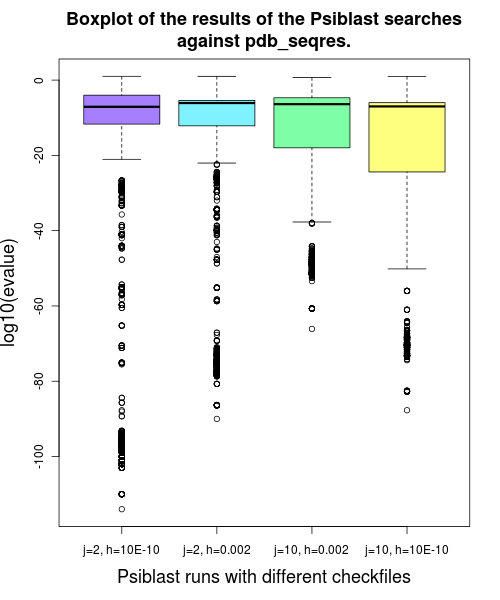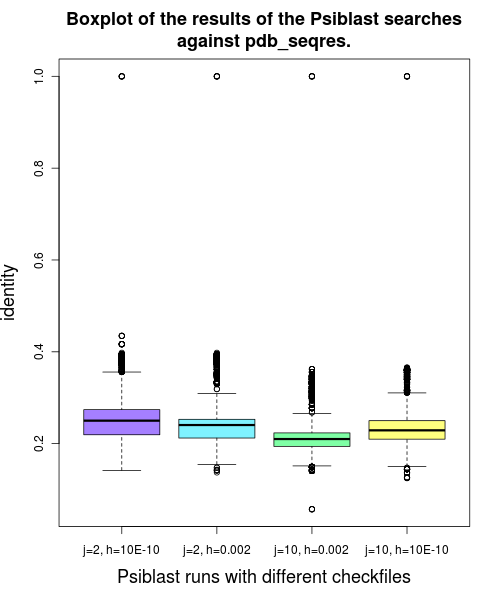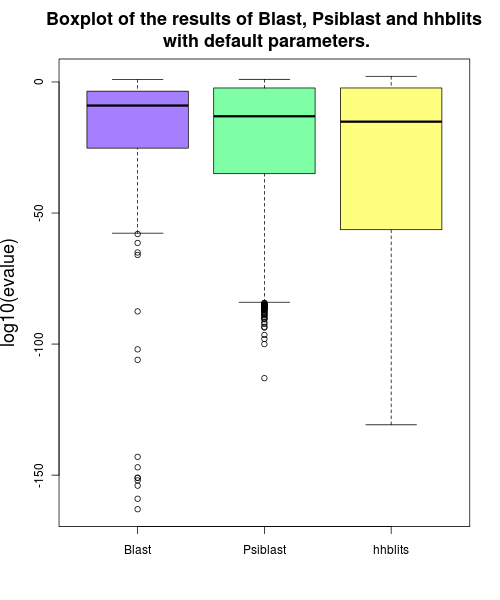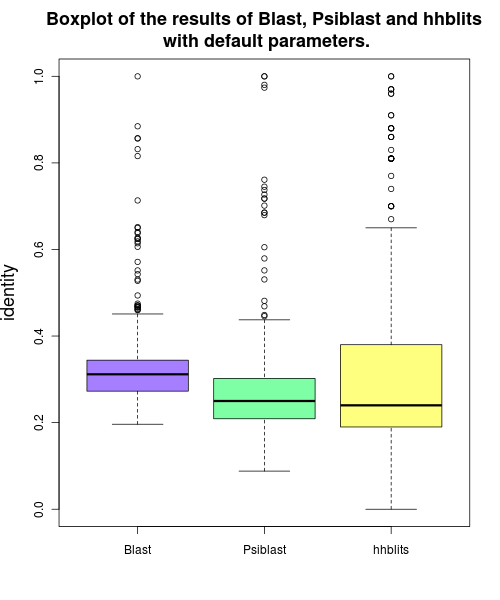Difference between revisions of "Task 2: Alignments"
| Line 33: | Line 33: | ||
</figtable> |
</figtable> |
||
| − | <xr id="blast distribution"/> shows the E-value and identity distributions of the Blast search hits. |
+ | <xr id="blast distribution"/> shows the E-value and identity distributions of the Blast search hits. |
| − | The Blast results only contain 13 PDB IDs. Nevertheless, the number of shared CATH classes betwen HFE and the hits were computed as described above. |
||
| − | Of 13 pdb hits, only 3 share all domain fild classes with HFE, 6 have one domain fold class in commom and 4 even none. |
||
| + | Table 1 shows the E-value and identity distributions of all unfiltered Blast search hits. |
||
| − | {| border="1" |
||
| + | There are only a few hits with a very low evalue of 1e-160, but most signigicant hits have an evalue between 1e-40 and 1e-50 (left small peak in a)). Most results have a worse evalue above 1e-20. The histogram of the sequence identity b) shows that nearly all hits have an identity between 20% to 40% to the query. |
||
| − | |+ Histogram of the number of shared CATH classes between HFE and the Blast hits. |
||
| + | |||
| − | ! number of same fold classes !! frequency |
||
| + | The Blast results only contain 13 PDB IDs. Nevertheless, the number of shared CATH classes between the reference sequence HFE and the hits were computed as described in the [[Lab journal task 2]]. |
||
| + | |||
| + | <css> |
||
| + | table.colBasic2 { |
||
| + | margin-left: auto; |
||
| + | margin-right: auto; |
||
| + | border: 2px solid black; |
||
| + | border-collapse:collapse; |
||
| + | width: 70%; |
||
| + | } |
||
| + | .colBasic2 th,td { |
||
| + | padding: 3px; |
||
| + | border: 2px solid black; |
||
| + | } |
||
| + | .colBasic2 td { |
||
| + | text-align:left; |
||
| + | } |
||
| + | .colBasic2 tr th { background-color:#efefef; color: black;} |
||
| + | .colBasic2 tr:first-child th { background-color:#adceff; color:black;} |
||
| + | </css> |
||
| + | |||
| + | <figtable id="blast cath"> |
||
| + | {|class="colBasic2" align="left" |
||
| + | ! number of same fold classes || frequency |
||
|- |
|- |
||
! 0 |
! 0 |
||
| Line 50: | Line 72: | ||
! 2 |
! 2 |
||
| 3 |
| 3 |
||
| + | |+ style="caption-side: bottom; text-align: left" |<font size=2>'''Table 1:''' Histogram of the number of shared CATH classes between HFE and the Blast hits. |
||
|} |
|} |
||
| + | </figtable> |
||
| + | The <xr id="blast cath"/> shows, that only 3 of the 13 pdb hist share all domain fold classes with HFE, 6 of the hits have one domain fold class in commom with the reference and 4 even none. Besides, only 6 of the 13 pdb hits are in the same COPS L30 group as the HFE protein. |
||
| − | |||
| − | + | Those numberst indicate, that some of the Blast hits are not really related to HFE and thus false positives. |
|
| − | |||
| − | All results indicate, that some of the Blast hits are not really related to HFE and thus false positives. |
||
| − | |||
===Psiblast=== |
===Psiblast=== |
||
| − | Four different |
+ | Four different Psiblast runs against big_80 where done using the following four parameter combinations: |
| − | *2 iterations |
+ | *2 iterations and default E-value cutoff 0.002 (j=2, h=2) |
| − | * |
+ | *2 iterations and E-value cutoff 10E-10 (j=2, h=10E-10) |
| − | *default E-value cutoff |
+ | *10 iterations and default E-value cutoff 0.002 (j=10, h=2) |
| − | *E-value cutoff 10E-10 |
+ | *10 iterations and E-value cutoff 10E-10 (j=10, h=10E-10) |
| − | |||
| − | |||
| − | |||
| − | The evalue |
+ | The evalue and sequence identity distributions of the hits from the four runs were compared to identify the best parameter combination. |
| − | <figtable id="psiblast |
+ | <figtable id="psiblast boxplot"> |
{| align="center" |
{| align="center" |
||
| − | |align="center" | [[File: |
+ | |align="center" | [[File:psi_box_e.png|center|frame|'''a)''' Boxplot of the log(evalue) of the four different Psiblast searches against big_80: 2 iterations with default evalue cutoff (0.002) and 10E-10 and 10 iterations with default evalue cutoff (0.002) and 10E-10. The thick black line inside the box is the median and the upper and lower end of the box the 25% and 75% quantils. The single points above the whiskers are outliers.]] |
| − | |align="center" | [[File: |
+ | |align="center" | [[File:psi_box_i.png|center|frame|'''b)''' Boxplot of the identity of the results of the four different Psiblast search against big_80: 2 iterations with default evalue cutoff (0.002) and 10E-10 and 10 iterations with default evalue cutoff (0.002) and 10E-10. The thick black line inside the box is the median and the upper and lower end of the box the 25% and 75% quantils. The single points above and below the whiskers are outliers.]] |
| − | |+ style="caption-side: bottom; text-align: left" |<font size=1.5>'''Figure 2:''' E-value distribution of the results from the four Psiblast runs |
+ | |+ style="caption-side: bottom; text-align: left" |<font size=1.5>'''Figure 2:''' E-value and percent sequence identity distribution of the results from the four Psiblast runs against big_80. |
|} |
|} |
||
</figtable> |
</figtable> |
||
| + | <figtable id="psiblast summary"> |
||
| − | |||
| + | {|class="colBasic2" align="right" |
||
| − | |||
| + | |+. |
||
| − | <figtable id="psiblast identity"> |
||
| + | ! || colspan="4" |Psiblast parameters |
||
| − | {| align="center" |
||
| + | |- |
||
| − | |align="center" | [[File:psi_hist_i.png|center|frame|'''a)''' Histogram of the identity distribution of the results of the four different Psiblast search against big_80: 2 iterations with default evalue cutoff (0.002) and 10E-10 and 10 iterations with default evalue cutoff(0.002) and 10E-10. The x-axis shows the relative identity between the query and the hits.]] |
||
| + | ! || j=2, h=0.002 || j=2, h=10E-10 || j=10, h=0.002 || j=10, h=10E-10 |
||
| − | |align="center" | [[File:psi_box_i.png|center|frame|''' b)''' Boxplot of the identity of the results of the four different Psiblast search against big_80: 2 iterations with default evalue cutoff (0.002) and 10E-10 and 10 iterations with default evalue cutoff(0.002) and 10E-10. The thick black line inside the box is the median and the upper and lower end of the box the 25% and 75% quantils. The single points above and below the whiskers are outliers.]] |
||
| − | |+ style="caption-side: bottom; text-align: left" |<font size=1.5>'''Figure 2:'''Identity distribution of the results from the four Psiblast runs in big_80. |
||
| − | |} |
||
| − | </figtable> |
||
| − | |||
| − | The evalue an identity distributions of the four runs are plotted above. |
||
| − | |||
| − | The boxplot of the evalue distribution shows, that the default parameter settings (j=2 and h=0.002) can be considered as the best. The median of log(evalue) is higher than in all the other 3 psiblast runs. This indicates that the percentage of hits with a good evalue is higher in the default psiblast run than in the other three. Besides, the sequence identity of the median is also the highest with the default parameters. |
||
| − | |||
| − | The results of the CATH and COPS classification analysis are listed below: |
||
| − | |||
| − | |||
| − | {| border="1" |
||
| − | |+ Comparison of the results of the four Psiblast searches against big_80. |
||
| − | ! psiblast parameters !! j=2, h=0.002 !! j=2, h=10E-10 !! j=10, h=0.002 !! j=10, h=10E-10 |
||
|- |
|- |
||
! # hits |
! # hits |
||
| Line 106: | Line 110: | ||
| 66 || 72 || 56 || 66 |
| 66 || 72 || 56 || 66 |
||
|- |
|- |
||
| + | ! rowspan="3" | CATH classes in common with HFE || 0 |
||
| − | ! 0 CATH class |
||
| 21 || 21 || 20 || 21 |
| 21 || 21 || 20 || 21 |
||
|- |
|- |
||
| − | ! 1 |
+ | ! 1 |
| 42 || 48 || 33 || 42 |
| 42 || 48 || 33 || 42 |
||
|- |
|- |
||
| − | ! 2 |
+ | ! 2 |
| 3 || 3 || 3 || 3 |
| 3 || 3 || 3 || 3 |
||
|- |
|- |
||
| − | !same L30 group |
+ | ! # hits within same L30 group |
| 6 || 6 || 6 || 6 |
| 6 || 6 || 6 || 6 |
||
|- |
|- |
||
| + | |+ style="caption-side: bottom; text-align: left" |<font size=2>'''Table 2:''' Comparison of the results of the four Psiblast searches against big_80. |
||
|} |
|} |
||
| + | </figtable> |
||
| + | <xr id="psiblast summary"/> summarises the results of the different Psiblst runs. The run with default parameter settings (j=2 and h=0.002) found the least hits. |
||
| − | There are 1095 proteins in the same COPS L30 group as the query HFE. Since the big_80 datatbase does not contain all proteins from pdb, the quality of the program cannot be assesed using the COPS L30 group of HFE. Nevertheless, of the found pdb hits only a few belong to the same L30 and share the same CATH fold classes with HFE. |
||
| + | Nevertheless, the boxplot of the evalue distribution (<xr id="psiblast evalue"/> a)) shows, that the default parameters can be considered the best: the median of the log(evalue) is smaller higher than the median of the other 3 psiblast runs. This indicates that the percentage of hits with a low and thus significant evalue is higher in the default psiblast run than in the other three. |
||
| + | Besides, the default parameters also led to a higher percent sequence identity as indicated by the median of the cyan box in <xr id="psiblast evalue"/> b). |
||
| + | The number of PDB hits varies a bit among the different runs, but all found 3 proteins with the same two CATH classes as the query. |
||
| + | There are 1095 proteins in the same COPS L30 group as the query HFE. Since the big_80 datatbase does not contain all proteins from pdb, the quality of the program cannot be assesed using the COPS L30 group of HFE. Nevertheless, of the found pdb hits only 6 proteins that belong to the same L30 group. |
||
| + | |||
| + | ====PDB search==== |
||
To get more pdb ids, we also did 4 psiblast searches against /mnt/home/rost/kloppmann/data/blast_db/pdb_seqres using the profiles created with big_80. Those four results were compared as well. |
To get more pdb ids, we also did 4 psiblast searches against /mnt/home/rost/kloppmann/data/blast_db/pdb_seqres using the profiles created with big_80. Those four results were compared as well. |
||
| − | <figtable id="psiblast pdb |
+ | <figtable id="psiblast pdb"> |
{| align="center" |
{| align="center" |
||
| − | |align="center" | [[File:pdb_psi_hist_e.png|center|frame|'''a)''' Histogram of the log(evalue) distribution of the results of the four Psiblast searches against pdb_seqres using the checkpoint files from the runs before. (2 iterations with default evalue cutoff (0.002) and 10E-10 and 10 iterations with default evalue cutoff(0.002) and 10E-10). The x-axis shows the natural logarithm of the evalue and the y-axis the frequency. The better the evalue the smaller is log(evalue).]] |
||
|align="center" | [[File:pdb_psi_box_e.png|center|frame|''' b)''' Boxplot of the log(evalue) of the four different Psiblast searches against pdb_seqres using the checkpoint files from the runs before. (2 iterations with default evalue cutoff (0.002) and 10E-10 and 10 iterations with default evalue cutoff(0.002) and 10E-10). The thick black line inside the box is the median and the upper and lower end of the box the 25% and 75% quantils. The single points below the whiskers are outliers.]] |
|align="center" | [[File:pdb_psi_box_e.png|center|frame|''' b)''' Boxplot of the log(evalue) of the four different Psiblast searches against pdb_seqres using the checkpoint files from the runs before. (2 iterations with default evalue cutoff (0.002) and 10E-10 and 10 iterations with default evalue cutoff(0.002) and 10E-10). The thick black line inside the box is the median and the upper and lower end of the box the 25% and 75% quantils. The single points below the whiskers are outliers.]] |
||
| − | |+ style="caption-side: bottom; text-align: left" |<font size=1.5>'''Figure 2:''' E-value distribution of the the results from four Psiblast runs in pdb_seqres. |
||
| − | |} |
||
| − | </figtable> |
||
| − | |||
| − | |||
| − | <figtable id="psiblast pdb identity"> |
||
| − | {| align="center" |
||
| − | |align="center" | [[File:pdb_psi_hist_i.png|left|frame|'''a)''' Histogram of the identity distribution of the results of the four different Psiblast searches against pdb_seqres using the checkpoint files from the runs before. (2 iterations with default evalue cutoff (0.002) and 10E-10 and 10 iterations with default evalue cutoff(0.002) and 10E-10). The x-axis shows the relative identity between the query and the hits.]] |
||
|align="center" | [[File:pdb_psi_box_i.png|center|frame|Boxplot of the identity of the results of the four different Psiblast searches against pdb_seqres using the checkpoint files from the runs before. (2 iterations with default evalue cutoff (0.002) and 10E-10 and 10 iterations with default evalue cutoff(0.002) and 10E-10). The thick black line inside the box is the median and the upper and lower end of the box the 25% and 75% quantils. The single points above and below the whiskers are outliers.]] |
|align="center" | [[File:pdb_psi_box_i.png|center|frame|Boxplot of the identity of the results of the four different Psiblast searches against pdb_seqres using the checkpoint files from the runs before. (2 iterations with default evalue cutoff (0.002) and 10E-10 and 10 iterations with default evalue cutoff(0.002) and 10E-10). The thick black line inside the box is the median and the upper and lower end of the box the 25% and 75% quantils. The single points above and below the whiskers are outliers.]] |
||
| − | |+ style="caption-side: bottom; text-align: left" |<font size=1.5>'''Figure |
+ | |+ style="caption-side: bottom; text-align: left" |<font size=1.5>'''Figure 3:''' Evalue and sequence identity distributions of the hits from the four Psiblast runs against pdb_seqres. |
|} |
|} |
||
</figtable> |
</figtable> |
||
| + | <figtable id="psiblast summary"> |
||
| − | {| border="1" |
||
| + | {|class="colBasic2" align="right" |
||
| − | |+ Comparison of the results of the four Psiblast searches against pdb_seqres. |
||
| + | |+. |
||
| − | ! psiblast checkfiles !! j=2, h=0.002 !! j=2, h=10E-10 !! j=10, h=0.002 !! j=10, h=10E-10 |
||
| + | ! || colspan="4" |Psiblast parameters |
||
| + | |- |
||
| + | ! || j=2, h=0.002 || j=2, h=10E-10 || j=10, h=0.002 || j=10, h=10E-10 |
||
|- |
|- |
||
! # hits |
! # hits |
||
| 4307 || 4814 || 3874 || 4058 |
| 4307 || 4814 || 3874 || 4058 |
||
|- |
|- |
||
| + | ! rowspan="3" | CATH classes in common with HFE || 0 |
||
| − | ! 0 CATH class |
||
| 561 || 586 || 529 || 539 |
| 561 || 586 || 529 || 539 |
||
|- |
|- |
||
| Line 155: | Line 161: | ||
| 2798 || 3280 || 2397 || 2571 |
| 2798 || 3280 || 2397 || 2571 |
||
|- |
|- |
||
| − | ! 2 |
+ | ! 2 |
| 948 || 948 || 948 || 948 |
| 948 || 948 || 948 || 948 |
||
|- |
|- |
||
| − | !same L30 group |
+ | ! # hits within same L30 group |
| 1047 || 1053 || 1045 || 1052 |
| 1047 || 1053 || 1045 || 1052 |
||
|- |
|- |
||
| + | |+ style="caption-side: bottom; text-align: left" |<font size=2>'''Table 3:''' Comparison of the results of the four Psiblast searches against pdb_seqres. |
||
|} |
|} |
||
| + | </figtable> |
||
| + | |||
| + | The E-value and sequence identity distributions in <xr id="psiblast pdb"/> do not show a significant difference in the results, because the medians of all four E-value distributions are nearly the same. The last run with the parameter combination of j=10 and h=10E-10 has a higher percentage of low evalue hits, because the 25% Quantil is below those of the other distributions. But the run with j=2 and h=10E-10 lead to more hits with a higher sequence identity, because the median slightly lies above the other medians. Apart from the query sequence, there were no pdb hits with a sequence identity with more than 40% found. |
||
| + | |||
| + | Evaluating the CATH and SCOP annotations of the found hits revealed that all four searches found 948 hits with the same 2 CATH classes as the reference. Besides, all runs could find nearly all 1095 proteins that are in the same COPS L30 group as HFE. Therefore,the decision which of the parameter settings leads to the best results cannot be based ont the pdb hits, since the differences are minimal. Nevertheless, j=10, h=0.002 had the least hits, but the highest percentage of hits in the same L30 group as the query. It is thus best suited to find a high number of significant hits. |
||
| + | |||
| + | |||
| + | <figtable id="psiblast venn"> |
||
| + | {| align="center" |
||
| + | |align="center" | [[File:psiblast_venn.png|center|frame|bVenn diagramm of the overlapp between all hits from the four different searches.]] |
||
| + | |+ style="caption-side: bottom; text-align: left" |<font size=1.5>'''Figure 3:''' Evalue and sequence identity distributions of the hits from the four Psiblast runs against pdb_seqres. |
||
| + | |} |
||
| + | </figtable> |
||
| − | 1095 proteins are in the same COPS L30 group as HFE. The differnent psiblast searches found nearly all proteins that are in the same L30 group as HFE. Therefore,the |
||
| − | decision which of the parameter settings leads to the best results cannot be based ont he pdb hits, since the differences are minimal.Nevertheless, j=10, h=0.002 had the least hits, but the highest percentage of hits in the same L30 group as the query. |
||
| + | We also computed the hits overlap of the four different Psiblast searches in big_80 to see how comparable the found hits are. The overlap is illustrated in the Venn diagram in <xr id="psiblast venn"/>. |
||
| + | Additionally, we computed the overlap for the 100 best hits (based on evalue) of each of the runs. They were exactly the same in all four runs. Thus, the parameter settings only matter if a high number of hits is needed, but not if onyl the best hits of a search are used in further analyses. |
||
| − | We also checked how many ot the hits overlapped in the four different runs. The results are shown in the Venn diagramm below: |
||
| − | TODO Venn diagramm !!!! |
||
| − | Additionally, the 100 best hits of each of the runs were compared to the 100 best hits of all the other 3 runs. They were the same with all four parameter combinations. Thus, the parameter settings only matter if a high number of hits is needed, but not of onyl the best hits are used in further analyses. |
||
===HHblits=== |
===HHblits=== |
||
| + | [[File:hhblits_hist_e.png|left|frame|Evalue distribution of the results of the HHblits search with default parameters using the using the uniprot20_02Sep11 database. The x-axis shows the natural logarithm of the evalue and the y-axis the frequency. The better the evalue the smaller is log(evalue).]] |
||
| − | <figtable id="hhblits"> |
||
| − | {| align="center" |
||
| − | |align="center" | [[File:hhblits_hist_e.png|center|frame|'''a)''' Evalue distribution of the results of the HHblits search with default parameters using the using the uniprot20_02Sep11 database. The x-axis shows the natural logarithm of the evalue and the y-axis the frequency. The better the evalue the smaller the log(evalue).]] |
||
| − | |align="center" | [[File:hhblits_hist_i.png|center|frame''' b)''' |Identity distribution of the results of the HHblits search in the uniprot20_02Sep11 database using default parameters. The x-axis shows the relative identity between the query and the hits.]] |
||
| − | |+ style="caption-side: bottom; text-align: left" |<font size=1.5>'''Figure 2:'''Evalue and identity distribution of the hhblits results from uniprot20. |
||
| − | |} |
||
| − | </figtable> |
||
| + | [[File:hhblits_hist_i.png|center|frame|Identity distribution of the results of the HHblits search in the uniprot20_02Sep11 database using default parameters. The x-axis shows the relative identity between the query and the hits.]] |
||
| + | |||
| + | We executed hhblits with default parameters and searched the uniprot20_02Sep11 database. HHblits is an alignment search tool that searches in a database of clustered sequences. For each clusterrepresentative that matches the query, not only the hit itself, but all other clustermembers are reportet in the results list. |
||
| + | Thus, hhblits finds much more sequences than Blast and Psiblast. We found 2861 clusters and 37908 sequences in total. We used all sequences for the analysis, because one of hhblits most important features is the high number of good results. |
||
| + | |||
| + | <xr id ="????"/> a) shows the distribution of the log10 of the evalues of the hhblits hits. It is remarkable that HHblits finds so many hits with a very low evalue of 1E-130. One reason is, that the best hit belongs to a very large cluster. Nevertheless, in comparison to the Blast evalue distribution ( <xr id="?????"/> a)) is the percentage of hits with a high evalue much lower in the hhblits results. |
||
| + | |||
| + | There are several hits with a very low sequence identity to the query (see <xr id="?????"/> b)), but the distribution contains two peaks around 20% and 40% identity that indicate good hits. |
||
| − | It is remarkable that HHblits finds so many hits with a very low evalue. This can maybe explained by the fact, that hhblits found several clusters with a good evalue. Since used all proteins in the clusters for the analyses and not only the cluster representative the number of hits is clearly higher than the number of hits from the Blast and Psiblast searches. |
||
===Comparison=== |
===Comparison=== |
||
| + | [[File:compDefault_e.png|left|frame| ]] |
||
| − | <figtable id="hhblits"> |
||
| + | |||
| − | {| align="center" |
||
| − | + | [[File:compDefault_i.png|center|frame| ]] |
|
| + | |||
| − | |align="center" |[[File:compDefault_i.png|center|frame|''' b)''' TODO idenity]] |
||
| + | |||
| − | |+ style="caption-side: bottom; text-align: left" |<font size=1.5>'''Figure 2:''' Comparison of Blast, Psiblast and hhblits with respect to the E-value and the identity. |
||
| + | We used the results of the Psiblast run with 2 iterations and an evalue cutoff of 2e-3, because we also used default parameters for Blast and hhblits and because we also recieved the best results with this parameters. |
||
| + | We compared the evalue and identity distributions. figure ???? a) clearly shows that Blast has the lowest evalues, but the percentage of low evalue hits is higher in the hhblits results. The median sequence identity has the highest value among the Blast hits. |
||
| + | |||
| + | The overlap between all hits and the top 100 hits are shown in figur ??? a) and b). |
||
| + | |||
| + | Venn diagramm! |
||
| + | |||
| + | |||
| + | <figtable id="psiblast summary"> |
||
| + | {|class="colBasic2" align="right" |
||
| + | ! search tool || colspan=6 |rank of hit |
||
| + | |- |
||
| + | ! Psiblast |
||
| + | | 1 || 2 || 3 || 4 || 5 || 6 |
||
| + | |- |
||
| + | ! Blast |
||
| + | | 1 || 3 || 2 || 52 || 109 || 81 |
||
| + | |- |
||
| + | ! hhblits |
||
| + | | 2 || not found || not found || not found || not found || not found |
||
| + | |+ style="caption-side: bottom; text-align: left" |<font size=2>'''Table ????:''' Rank of the top 6 PSiblast hits in the Blast and hhblits results. |
||
|} |
|} |
||
| − | </figtable> |
+ | </figtable> |
| + | |||
| + | The top 6 Psiblast hits are all present in the Blast results and the first 3 hits are the same. This confirms that Blast and Psiblast are very similar. |
||
| + | Hhblits, on the contrary, has definitely not the same results as Blast and Psiblast. From the top 6 Psiblast hits, only the first on is present in the second best cluster. This proves, that hhblis finds more distant related hits, which is also indicated by the low median sequence identity of the hhblits hits. |
||
| + | |||
| + | The best 5 hits from all three search tools belong to the MHC class I family and are thus correct hits. |
||
| + | |||
| + | |||
| + | |||
| + | |||
| − | TODO: Venn diagramms of hits overlap. |
||
== Multiple sequence alignments== |
== Multiple sequence alignments== |
||
Revision as of 11:45, 29 August 2013
Sequence alignments are a good start to analyse a new protein sequence. Alignment search tools such as Blast, Psiblast or hhblits can be used to find related protein sequences.
Contents
Sequence Searches
The HFE protein sequence was used to conduct sequence searches with the three different search tools Blast, Psiblast and hhblits. CATH and COPS, two protein structure classification databases, were used to evaluate and compare the results of the different tools.
CATH is a database that hierarchically classifies all domain structures from PDB. This hierarchy consists of four major levels: 1. Class 2. Architecture 3. Topology 4. Homologous superfamily
We compared the first level of the CATH hierarchy (Class) to check whether the hits have the same fold class as the query. The class of a domain is determined by its secondary structure composition (mostly alpha, mostly beta, mixed alpha/beta or few secondary structures). Each domain of a protein is assigned to a CATH class, this means, that one query protein can consist of several fold classes, one for each domain. The HFE protein consists of two domains that belong to the CATH fold class 2 and 3.
Another database for protein structure clustering is COPS. It consists of different structural groups that contain all proteins with a structural similarity above a threshold. For example, all proteins in the L30 group have a structural similarity of at least 30% percent. This means that if two proteins are not in the same L30 group, they have less than 30% structural similarity. The L30 groups of the hits were determined to check if they are in the same group as the HFE protein or not.
Blast
The Blast search in the big_80 database yielded 1504 hits.
<figtable id="blast distribution">
</figtable>
<xr id="blast distribution"/> shows the E-value and identity distributions of the Blast search hits.
Table 1 shows the E-value and identity distributions of all unfiltered Blast search hits.
There are only a few hits with a very low evalue of 1e-160, but most signigicant hits have an evalue between 1e-40 and 1e-50 (left small peak in a)). Most results have a worse evalue above 1e-20. The histogram of the sequence identity b) shows that nearly all hits have an identity between 20% to 40% to the query.
The Blast results only contain 13 PDB IDs. Nevertheless, the number of shared CATH classes between the reference sequence HFE and the hits were computed as described in the Lab journal task 2.
<css> table.colBasic2 { margin-left: auto; margin-right: auto; border: 2px solid black; border-collapse:collapse; width: 70%; } .colBasic2 th,td { padding: 3px; border: 2px solid black; } .colBasic2 td { text-align:left; } .colBasic2 tr th { background-color:#efefef; color: black;} .colBasic2 tr:first-child th { background-color:#adceff; color:black;} </css>
<figtable id="blast cath">
| number of same fold classes | frequency |
|---|---|
| 0 | 4 |
| 1 | 6 |
| 2 | 3 |
</figtable>
The <xr id="blast cath"/> shows, that only 3 of the 13 pdb hist share all domain fold classes with HFE, 6 of the hits have one domain fold class in commom with the reference and 4 even none. Besides, only 6 of the 13 pdb hits are in the same COPS L30 group as the HFE protein. Those numberst indicate, that some of the Blast hits are not really related to HFE and thus false positives.
Psiblast
Four different Psiblast runs against big_80 where done using the following four parameter combinations:
- 2 iterations and default E-value cutoff 0.002 (j=2, h=2)
- 2 iterations and E-value cutoff 10E-10 (j=2, h=10E-10)
- 10 iterations and default E-value cutoff 0.002 (j=10, h=2)
- 10 iterations and E-value cutoff 10E-10 (j=10, h=10E-10)
The evalue and sequence identity distributions of the hits from the four runs were compared to identify the best parameter combination.
<figtable id="psiblast boxplot">
</figtable>
<figtable id="psiblast summary">
| Psiblast parameters | |||||
|---|---|---|---|---|---|
| j=2, h=0.002 | j=2, h=10E-10 | j=10, h=0.002 | j=10, h=10E-10 | ||
| # hits | 2564 | 3163 | 2601 | 3343 | |
| # PDB hits | 66 | 72 | 56 | 66 | |
| CATH classes in common with HFE | 0 | 21 | 21 | 20 | 21 |
| 1 | 42 | 48 | 33 | 42 | |
| 2 | 3 | 3 | 3 | 3 | |
| # hits within same L30 group | 6 | 6 | 6 | 6 | |
</figtable>
<xr id="psiblast summary"/> summarises the results of the different Psiblst runs. The run with default parameter settings (j=2 and h=0.002) found the least hits. Nevertheless, the boxplot of the evalue distribution (<xr id="psiblast evalue"/> a)) shows, that the default parameters can be considered the best: the median of the log(evalue) is smaller higher than the median of the other 3 psiblast runs. This indicates that the percentage of hits with a low and thus significant evalue is higher in the default psiblast run than in the other three. Besides, the default parameters also led to a higher percent sequence identity as indicated by the median of the cyan box in <xr id="psiblast evalue"/> b).
The number of PDB hits varies a bit among the different runs, but all found 3 proteins with the same two CATH classes as the query. There are 1095 proteins in the same COPS L30 group as the query HFE. Since the big_80 datatbase does not contain all proteins from pdb, the quality of the program cannot be assesed using the COPS L30 group of HFE. Nevertheless, of the found pdb hits only 6 proteins that belong to the same L30 group.
PDB search
To get more pdb ids, we also did 4 psiblast searches against /mnt/home/rost/kloppmann/data/blast_db/pdb_seqres using the profiles created with big_80. Those four results were compared as well.
<figtable id="psiblast pdb">
</figtable>
<figtable id="psiblast summary">
| Psiblast parameters | |||||
|---|---|---|---|---|---|
| j=2, h=0.002 | j=2, h=10E-10 | j=10, h=0.002 | j=10, h=10E-10 | ||
| # hits | 4307 | 4814 | 3874 | 4058 | |
| CATH classes in common with HFE | 0 | 561 | 586 | 529 | 539 |
| 1 CATH class | 2798 | 3280 | 2397 | 2571 | |
| 2 | 948 | 948 | 948 | 948 | |
| # hits within same L30 group | 1047 | 1053 | 1045 | 1052 | |
</figtable>
The E-value and sequence identity distributions in <xr id="psiblast pdb"/> do not show a significant difference in the results, because the medians of all four E-value distributions are nearly the same. The last run with the parameter combination of j=10 and h=10E-10 has a higher percentage of low evalue hits, because the 25% Quantil is below those of the other distributions. But the run with j=2 and h=10E-10 lead to more hits with a higher sequence identity, because the median slightly lies above the other medians. Apart from the query sequence, there were no pdb hits with a sequence identity with more than 40% found.
Evaluating the CATH and SCOP annotations of the found hits revealed that all four searches found 948 hits with the same 2 CATH classes as the reference. Besides, all runs could find nearly all 1095 proteins that are in the same COPS L30 group as HFE. Therefore,the decision which of the parameter settings leads to the best results cannot be based ont the pdb hits, since the differences are minimal. Nevertheless, j=10, h=0.002 had the least hits, but the highest percentage of hits in the same L30 group as the query. It is thus best suited to find a high number of significant hits.
<figtable id="psiblast venn">
File:Psiblast venn.png bVenn diagramm of the overlapp between all hits from the four different searches. |
</figtable>
We also computed the hits overlap of the four different Psiblast searches in big_80 to see how comparable the found hits are. The overlap is illustrated in the Venn diagram in <xr id="psiblast venn"/>.
Additionally, we computed the overlap for the 100 best hits (based on evalue) of each of the runs. They were exactly the same in all four runs. Thus, the parameter settings only matter if a high number of hits is needed, but not if onyl the best hits of a search are used in further analyses.
HHblits
We executed hhblits with default parameters and searched the uniprot20_02Sep11 database. HHblits is an alignment search tool that searches in a database of clustered sequences. For each clusterrepresentative that matches the query, not only the hit itself, but all other clustermembers are reportet in the results list. Thus, hhblits finds much more sequences than Blast and Psiblast. We found 2861 clusters and 37908 sequences in total. We used all sequences for the analysis, because one of hhblits most important features is the high number of good results.
<xr id ="????"/> a) shows the distribution of the log10 of the evalues of the hhblits hits. It is remarkable that HHblits finds so many hits with a very low evalue of 1E-130. One reason is, that the best hit belongs to a very large cluster. Nevertheless, in comparison to the Blast evalue distribution ( <xr id="?????"/> a)) is the percentage of hits with a high evalue much lower in the hhblits results.
There are several hits with a very low sequence identity to the query (see <xr id="?????"/> b)), but the distribution contains two peaks around 20% and 40% identity that indicate good hits.
Comparison
We used the results of the Psiblast run with 2 iterations and an evalue cutoff of 2e-3, because we also used default parameters for Blast and hhblits and because we also recieved the best results with this parameters.
We compared the evalue and identity distributions. figure ???? a) clearly shows that Blast has the lowest evalues, but the percentage of low evalue hits is higher in the hhblits results. The median sequence identity has the highest value among the Blast hits.
The overlap between all hits and the top 100 hits are shown in figur ??? a) and b).
Venn diagramm!
<figtable id="psiblast summary">
| search tool | rank of hit | |||||
|---|---|---|---|---|---|---|
| Psiblast | 1 | 2 | 3 | 4 | 5 | 6 |
| Blast | 1 | 3 | 2 | 52 | 109 | 81 |
| hhblits | 2 | not found | not found | not found | not found | not found |
</figtable>
The top 6 Psiblast hits are all present in the Blast results and the first 3 hits are the same. This confirms that Blast and Psiblast are very similar. Hhblits, on the contrary, has definitely not the same results as Blast and Psiblast. From the top 6 Psiblast hits, only the first on is present in the second best cluster. This proves, that hhblis finds more distant related hits, which is also indicated by the low median sequence identity of the hhblits hits.
The best 5 hits from all three search tools belong to the MHC class I family and are thus correct hits.
Multiple sequence alignments
The following data sets were chosen for the Multiple Sequence Alignments:
Below 30% SeqID:
| AC Number | Sequence Identity |
| F6JYA9 | 0.29 |
| D9J389 | 0.28 |
| D5MSB3 | 0.27 |
| B3FRK2 | 0.20 |
| 3ov6_A | 0.22 |
| 1p7k_L | 0.21 |
| H0Y1D0 | 0.20 |
| B3FRK3 | 0.18 |
| Q8HWL2 | 0.17 |
Above 60% SeqID:
G5BQE5 0.67| AC Number | Sequence Identity |
| B4DDZ1 | 0.83 |
| Q5EEZ1 | 0.76 |
| G3THV5 | 0.75 |
| G1MBW1 | 0.73 |
| H0VAR7 | 0.72 |
| F1PX48 | 0.71 |
| G1T7D7 | 0.70 |
| O35799 | 0.68 |
Whole range of SeqID:
| AC Number | Sequence Identity |
| B4DDZ1 | 0.83 |
| Q5EEZ1 | 0.76 |
| G1MBW1 | 0.73 |
| H0VAR7 | 0.72 |
| F1PX48 | 0.71 |
| G1T7D7 | 0.70 |
| G5BQE5 | 0.67 |
| Q95IT9 | 0.38 |
| 2qrt-A | 0.38 |
| Q8HX83 | 0.36 |
| F6WCX4 | 0.34 |
| F6JYA9 | 0.29 |
| D9J389 | 0.28 |
| D5MSB3 | 0.27 |
| 2zok_E | 0.24 |
| H0Y1D0 | 0.20 |
| Q8SNJ4 | 0.22 |
| B3FRK3 | 0.18 |
| Q8HWL2 | 0.17 |
pdb:
1p7k_L 0.21
3ov6_A 0.22
2qrt_A 0.38
2zok_E 0.24
ClustalW
Below 30% SeqID: ClustalW_Below_30
Above 60% SeqID: ClustalW_Above_60
Whole range of SeqID: ClustalW_whole
MAFFT
Below 30%:MAFFT_30
Above 60%: MAFFT_60
Whole range: MAFFT_whole
T-Coffee
Below 30%: Tcoffee_30
Above 60%:Tcoffee_60
Whole range: Tcoffee_whole
